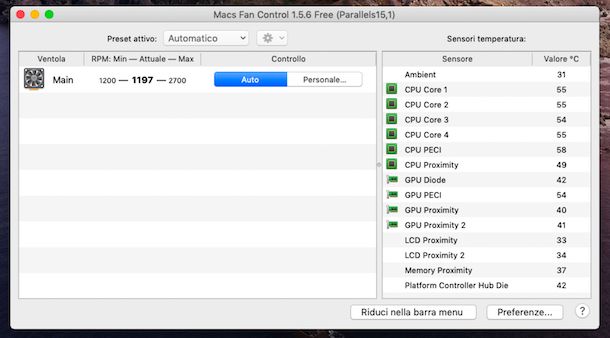

Of course, the low frequency caused nasty vibrations so I gave up on this approach. And even like this I couldn’t get it to run at low duty cycles. I had to lower the PWM frequency even more into the tens of Hz range so it would spin at all. With the larger fan from the supply things only got worse. And probably as a result of the low PWM frequency the motion of the fan didn’t look or sound very smooth. It all worked but I had to chose a quite low PWM frequency in order to make the fan spin at lower duty cycles.

So I did the necessary programming (and debugging) and attached a small fan.
#WHICH TEMPERATURE TO LOOK AT MACS FAN CONTROL CODE#
As a nice side effect I can now also compile code for and program the fancier PICs like the DSPics and PIC32s. So after a little bit of research I ordered a PICkit3 and downloaded the MPLAB IDE. And neither does my MikroProg programmer. My trusted Mikroelectronika MikroC for PIC compiler doesn’t know that chip. My first surprise came when I first wanted to program the PIC. So all I need to do is to measure the temperature, calculate the desired fan speed and set the PWM duty cycle accordingly. The PIC chosen here runs at up to 32MHz on an internal oscillator, has an internal voltage reference (of 1.024, 2.048 or 4.096V), six PWM modules and plenty of other nice features while comming in a small 14-pin package. It’s simple: A linear 5V regulator, a PIC16F18325 microcontroller, an LMT86 temperature sensor and a N-channel mosfet. I’ve just recently made some LED dimmers and the technology needed here seemed to be very similar. Stick with the original fan and just put a PWM controller in between.

So I could just plug anything in between the board and the fan. I was pleased to see that the fan connects to the main board by means of a standard two-pin 100mil header. Most surprisingly, this voltage is not ground-referenced but symmetric around ground, i.e. So there’s no PWM or anything but the supply voltage just varies in (I think) four steps from 7.4 to 12 volts.
:max_bytes(150000):strip_icc()/how-to-check-macbook-temperature-51841464-3aa2d26ccbe9448fa74f087e753e4dd0.jpg)
I also found out that the supply uses linear control. After beaking some seals and opening the case I found a 60圆0x25mm 12V fan of Chinese origin. So the first step was to open the supply and to see what kind of fan it uses and how it is controlled. But the E3645A ( this one here does a better job) ran its fan at crazy speeds while the case still had this cold metallic feel to it. So little cooling is needed most of the time. When working with microcontroller designs it’s rare for me to pull more than a few tens of milliamps. And most of the time I’m hardly pulling any current. But my supply just sits on a shelf at, say, 22 degrees ambiant. An for a supply that may be rack-mounted together with lots of other heat dissipating gear the worst-case might be quite demanding. But it doesn’t seem to measure the temperature at all but seems to calculate the necessary cooling in a worst-case condition. In my case the supply does control the speed of the fan. But very often a small fraction of the cooling would do just fine most of the time. Of course, the best temperature controlled fan in the world doesn’t help if you really need the cooling the fan is providing. That’s when the idea of this fan controller was born. For example when my Keysight E3645A lab power supply was making so much noise that I could hardly concentrate. I’m currently mainly working on my new anemometer design but once in a while I get distracted.


 0 kommentar(er)
0 kommentar(er)
